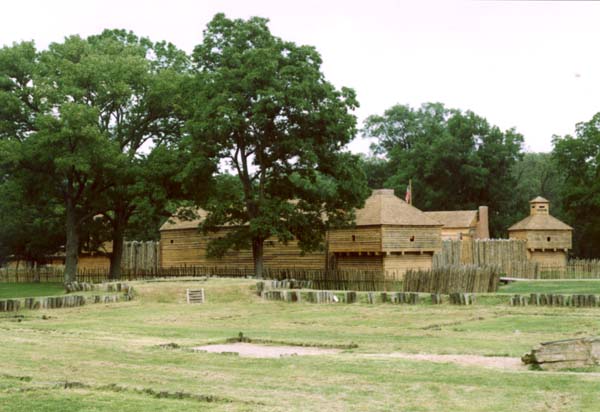Fort Massac

Reconstruction of Fort Massac
Original fort footprint in foreground
Donation to the Illlinois State Museum
Click image to enlarge.
Lewis and his party arrived at Fort Massac on November 11, 1803. He recruited George Drouillard there as an interpreter to the Indians. During the two days at the fort, Lewis also recruited John Newman and Joseph Whitehouse from the Captain's company.
The location along the Ohio River, above the confluence of the Mississippi and below that of the Tennessee, was strategically important. It was in the center of an area of trade and was a strategic location for the defence of French territory in Illinois. Massac began as a trading post in 1702, and in 1757 a fort was added to defend settlers from the Indians and the British. The fort was first abandoned in 1764.
The United States government moved into the deserted fort in 1794. Zebulon Pike commanded 40 men and protected the area. Captain Daniel Bissell took over in 1802 and stayed six years.
The fort was repaired again for use during the War of 1812. The area had
a few settlers and missionaries.
The Illinois State Museum Fort Massac Archaeological Collection
The Illinois State Museum is the repository for the Fort Massac Archaeological Collection. Transferred from a storage building at Fort Massac State Park to the Museum in 1987, the collection consists of 66 cubic feet of artifact collections, the vast majority retrieved by Paul Maynard between 1939 and 1942 during the course of excavations he directed in order to reconstruct the French Colonial fortification that once stood at the site. The collection includes a diverse assemblage of tableware ceramics, bottle glass, building hardware, and animal bone refuse from the late eighteenth and early nineteenth centuries. Also present are extensive documents and photographs related to Maynard’s investigations.
Ceramic Objects
(First image to the right) Late eighteenth and early nineteenth-century pearlware
ceramic sherds from the Fort Massac Archaeological Collection.
Top row, left to right: hand-painted teacup base; green-edge, basket weave-molded plate; blue transfer-printed plate. Bottom row, left to right: floral design teacup; hand-painted teacup; standard blue willow pattern, transfer-printed plate.
(Second image to the right) Late eighteenth and early nineteenth-century creamware and porcelain ceramic sherds from the Fort Massac Archaeological Collection. Top row, left to right: Royal pattern creamware plate; creamware saucer with polychrome overglaze; polychrome creamware bowl. Second row, left to right: underglaze blue Chinese porcelain bowl; mocha-decorated creamware bowl; octagon pattern creamware plate. Bottom, left: underglaze blue Chinese porcelain plate.
Metal Objects
(Third image to the right) Top row, left to right: frizzen from a flintlock gun; iron horseback-riding spur; stamped brass insignia plate for a U.S. Army cylindrical cap or shako (Artillery, Second Regiment, U.S.). Bottom row, left to right: iron belt buckle; iron door latch hardware.


